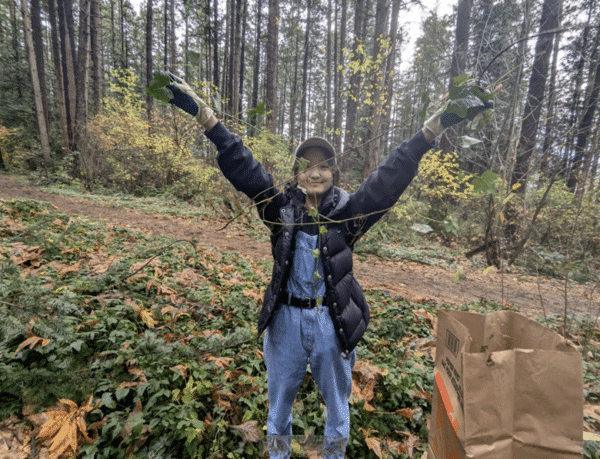Author: ISCBC youth volunteer Emily Winder
Scotch broom (Cytisus scoparius) is a prolific invasive species found mainly on Vancouver Island, but has also slowly spread to the Gulf Islands and mainland. It is a strong competitor with many native plant species and thrives in recently disturbed soil.
Do you ever gaze at a yellow-filled hillside and wonder how such a beautiful plant can be so destructive? When the first independent settler of BC, Captain Walter Colquhoun Grant, planted Scotch broom in the early 1850’s, it’s doubtful he knew what an impact it would have on our native species. Before awareness spread of how quickly it reproduced, it was used as a bank stabilizer for construction purposes due to its deep root system. Broom now thrives across Vancouver Island, especially where land development is on the rise.
Scotch broom crowds out native plant species, growing year-round and producing upwards of 3,500 seed pods that can remain viable for up to 30 years. Broom’s invasiveness is not limited to disturbing native plants. Due to the lack of open space for wildflowers, it limits habitat for birds and butterflies. One of our already fragile at-risk ecosystems, the Garry Oak woodlands, has been altered due to changes in soil nutrients caused by Scotch broom. There is also a major increase in fire risk associated with broom. Its deep roots carry a very high oil content making the plant extremely flammable.
Did you know?
- Scotch broom is a serious threat to our biodiversity.
- If we allow it to continue to spread, it will wipe out fragile ecosystems.
- It is important to raise awareness on the impact of its invasiveness.
- Introduced species can appear beautiful, but are usually far from harmless.
So, what can we do to help? Removing as much broom as possible seems to be the obvious answer. Due to its deep root system this can prove to be easier said than done. Seed pods germinate easily and grow well in disturbed soil. It is important to be thorough while extracting broom, while also remaining low impact to encourage regrowth and restoration of native species. There are many organizations, such as the Coastal Invasive Species Committee, Broombusters, and the Garry Oak Ecosystems Recovery Team, that offer detailed information on removal methods. Consulting the proper resources is key to improving chances of removing broom effectively.
Learn more about Scotch broom impacts and management.
Author Bio – Emily Winder
As a lifelong British Columbian, and avid conservationist, I enjoy spending most of my time outdoors. Our province holds so many wonderful natural treasures. Camping, hiking, and fishing are a few of my favourite past times. In the past, I have volunteered many hours aiding in wildlife rehabilitation. Although my time with the ISCBC has just begun, I am looking forward to the many opportunities that will become available to me in the future.
Citations
Scotch broom. (n.d). Nature Conservancy Canada. Retrieved from NCC: Scotch broom (natureconservancy.ca)
Scotch Broom. (n.d). Coastal Invasive Species Council. Retrieved from Scotch Broom – Coastal Invasive Species Committee (coastalisc.com)
Scotch Broom. (n,d).Retrieved from Scotch Broom | Islands Trust
Share


















